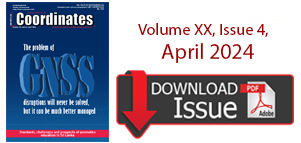| Imaging | |
IMAGING
Remote GeoSystems launches LineVision Google Earth Extension
Remote GeoSystems, Inc. have released the all new LineVision™ Google Earth Extension – commercial software for UAV, airborne & terrestrial mobile inspection and survey projects requiring georeferenced video playback, analysis, collaboration and reporting using Google Earth & other GIS applications. Now anyone with a GPS-enabled video camera, drone or geospatial DVR that can geotag video in the proper format can immediately load their videos and photos to Google Earth along with compatible KML and other traditional geospatial data. https://www.remotegeo.com
3D Repo wins European funding for C3ISP system
3D Repo is to play a key role in protecting industry from cyber attacks after winning a major research grant as part of a European Commission-funded project. Backed by a project fund of five million Euros, 3D Repo joins a consortium of 11 leading IT and communications organisations led by CNR, Italy’s National Research Council. Other members include Hewlett Packard Italiana, British Telecommunications and SAP. The aim of the project (http:// cordis.europa.eu/project/rcn/202687_ it.html) is to define a collaborative and confidential information sharing, analysis and protection framework as a service for cyber security management.
A survey by the European Union Agency for Network and Information Security (ENISA) revealed that three quarters of businesses have seen cyber security as a concern for some time, and most believed their business had been a victim of a targeted attack. In the UK alone, cyber crime’s annual cost is estimated at £27 billion, of which £21 billion involves companies.
China launches remotesensing satellite into orbit
China has launched an experimental satellite ‘’TK-1’’ from the Jiuquan Satellite Launch Center, in northwest China, that will be used for remote sensing, telecommunications and microsatellitebased experiments. The ‘TK-1’ is the first satellite developed independently by the China Aerospace Science and Industry Corporation (CASIC), while the ‘KT-2’ rocket, characterized by its high efficiency of load and adaptability, is one of five carrier systems in the commercial space plan of the referred company.
Chinese scientists use remotesensing tech to digitize Great Wall
Researchers from the Chinese Academy of Sciences (CAS) recently used remotesensing equipment in their efforts to restore a vanished section of the Great Wall in Northwest China’s Xinjiang Uyghur Autonomous Region.
By analyzing the local conditions of the landscape with remote-sensing technology, the researchers were able to recreate a digital model of the Great Wall. This section of the Great Wall was
built nearly 1,000 years ago to protect Xinjiang from invaders, but was gradually eroded over the centuries by wind and sand. Similar to radar, remote-sensing technology used in archeology makes use of electromagnetic waves to detect and observe relics located underground.
“Different from other areas of China, the Great Wall in Xinjiang didn’t have connected high walls but were separate fortresses located at main roads and passes and along river banks,” CAS researcher Nie Yueping told the People’s Daily. So far, more than 600 locations making up the Xinjiang Great Wall have been discovered. (Global Times) http://english.cas.cn/
Japan launches new spy satellite to keep eye on North Korea
Japan launched a new spy satellite, the country’s space agency said, as the region grows increasingly uneasy over North Korea’s quickening missile and nuclear programs. The Radar 5 unit was carried into space on Japan’s mainstay H-IIA rocket from a launch site in the country’s southwest. It is meant to replace an existing satellite that is approaching the end of its mission.
Tokyo currently maintains three optical satellites for daytime surveillance and three radar satellites for nighttime monitoring. Two of those are backups. The new satellite will succeed one of the three radar satellites that was launched in 2011. The satellites are officially for “information gathering” — a euphemism for spying — but are also used to monitor damage in the wake of natural disasters. http://www.japantimes.co.jp
China to contribute US$64 million to ‘Egypt Sat 2’ project
Egypt and China signed letters of cooperation on Egypt’s satellite project “Egypt Sat 2” which the Chinese government is contributing toward with US$64 million. Egypt and China are yet to conduct feasibility studies on the project, and planning to establish a vocational training center in the Suez Canal economic zone through a Chinese grant equivalent to US$7 billion, Minister of International Cooperation Sahar Nasr said. The letters of cooperation came in accordance with agreements during the latest visit of the Chinese president to Egypt. China will contribute to developing the skills of Egyptians, especially in the field of scientific research and remote sensing, as China is considered a leading country in these fields. Beside “Egypt Sat 2”, China will contribute to development projects in the Suez Canal axis, Nasr pointed out. http://www.egyptindependent.com
EEA and EuroGeographics Partnership
The cooperation agreement signed on 29 March between the European Environment Agency (EEA) and EuroGeographics signals a commitment to make more national authoritative geospatial information available through the European Commission’s flagship initiative for earth observation and monitoring.
The partnership agreement has five main objectives:
• To improve Copernicus access to EuroGeographics data and services, produced using official geospatial data from its members.
• To enhance the dialogue between Copernicus and EuroGeographics members.
• To foster knowledge exchange between Copernicus and EuroGeographics members.
• To promote awareness raising activities.
• To support initiatives to provide pan-European harmonised data services.
To facilitate coordination and communication between the two organisations, EuroGeographics is establishing a dedicated knowledge exchange network to share expertise and experiences. Feedback from the EEA will also provide invaluable input into the delivery of future European Location Services which are being developed by EuroGeographics and its members. http://copernicus.eu











 (No Ratings Yet)
(No Ratings Yet)




Leave your response!